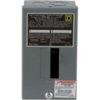If the breaker is 60A, why would you need to use 70A wire if your job gets harder as a result?
I am considering the Ampacity of each wire:
- AWG 6 Stranded Aluminium - Ampacity 40 Amps
- AWG 4 Stranded Aluminium - Ampacity 55 Amps
- AWG 3 Stranded Aluminium - Ampacity 65 Amps
- AWG 2 Stranded Aluminium - Ampacity 75 Amps
- AWG 6 Stranded Copper - Ampacity 55 Amps
- AWG 4 Stranded copper - Ampacity 70 Amps
- AWG 3 Stranded copper - Ampacity 100 Amps
- AWG 2 Stranded copper - Ampacity 115 Amps
Yes, you do definitely have to be concerned with the wire size the breaker size would accept.
IIRC, I had a 60 amp breaker and it would take no more than 6AWG.
You are correct, I will have to go with circuit breaker wire size. I have some AWG #6 stranded copper,
so I will compare the wires size with the aluminium wires.
On the topic of making another hole,
can you just put your new subpanel in the pathway to the the main panel, and connect through it?
This not really possible. The Romex wires are connected to the circuit breakers and immediately disappear into the ceiling.
Also I don't like to play too much with aluminium wires.
What I plan to do is to have a 'Y' junction in the path of the main panel.
And from this 'Y' junction I will be able to branch out a wires to connect the subpanel and the 30 A circuit breaker.
There is about
5 feet between the the main panel and the subpanel.
You might have to add a pigtail to get to the main panel from the subpanel, but that's no big deal.
I'm sorry but I cannot really follow what you try to explain to me.
By the way, you really only need 8 gauge to get 24amps (or even 30) at the plug 150' from the subpanel.
Probably not worth the difference, but thought I'd mention it.
I think you are right, I could downsize a little bit the wires and use #8 instead of #6,
which will help a lot when putting the 4 wires into the raceway.
Using stranded copper wires:
AWG 10 - Ampacity 30 Amps
- maximum length for a 3% voltage drop and 30 A is 93 ft.
- maximum length for a 3% voltage drop and 24 A is 116 ft.
AWG 8 - Ampacity 40 Amps
- maximum length for a 3% voltage drop and 30 A is 148 ft.
- maximum length for a 3% voltage drop and 24 A is 185 ft.
AWG 6 - Ampacity 55 Amps
- maximum length for a 3% voltage drop and 30 A is 235 ft.
- maximum length for a 3% voltage drop and 24 A is 294 ft.
If you do the splitting in the main panel, make sure you use one of the knockouts,
don't even think of cutting your own.
Also, there are split-stress-reliefs so you could knockout a slightly larger ring(probably two sizes up)
from the knockout that's already been knocked out, and install two independent cables in it,
each in their own cubby.
Alternatively, and this may be frowned upon, you could run them both through the same single knockout(might need to be bigger anyway), piggybacked.
I've never seen that done with large-gauge wire, though.
Honestly, adding a new knockout would be very helpful, but also would be tricky to make:
Increasing the size of the knockout would be as difficult.
Using a junction box might be simpler finally.









